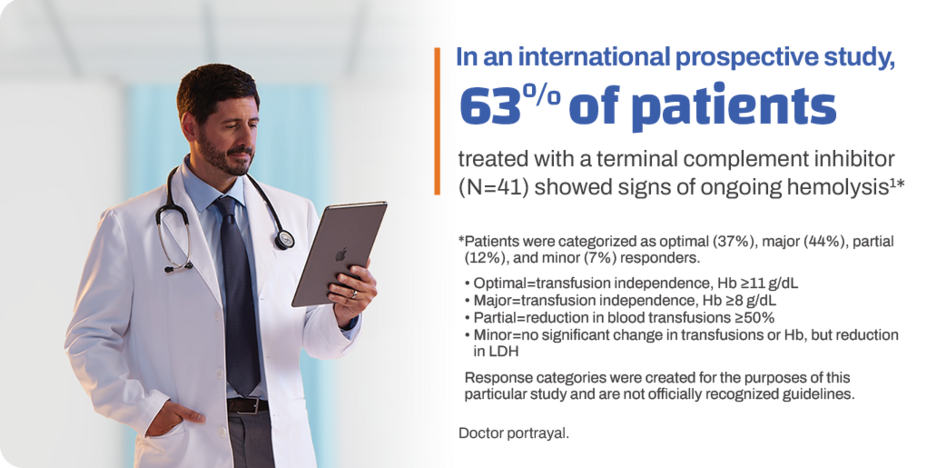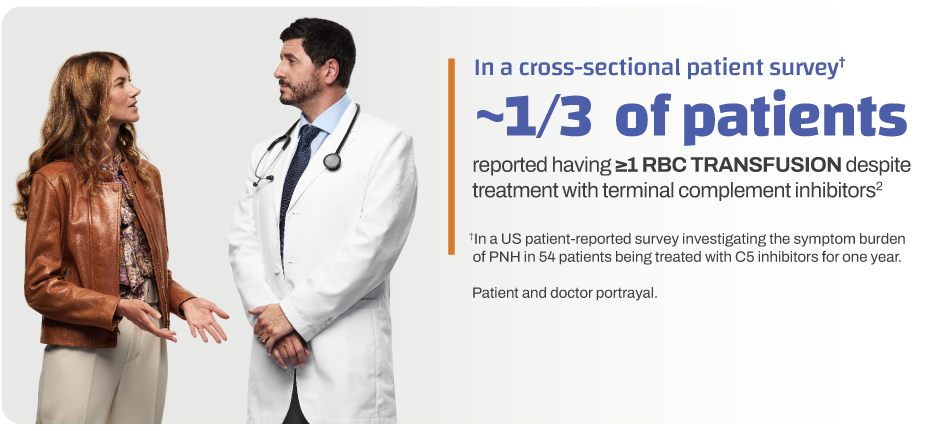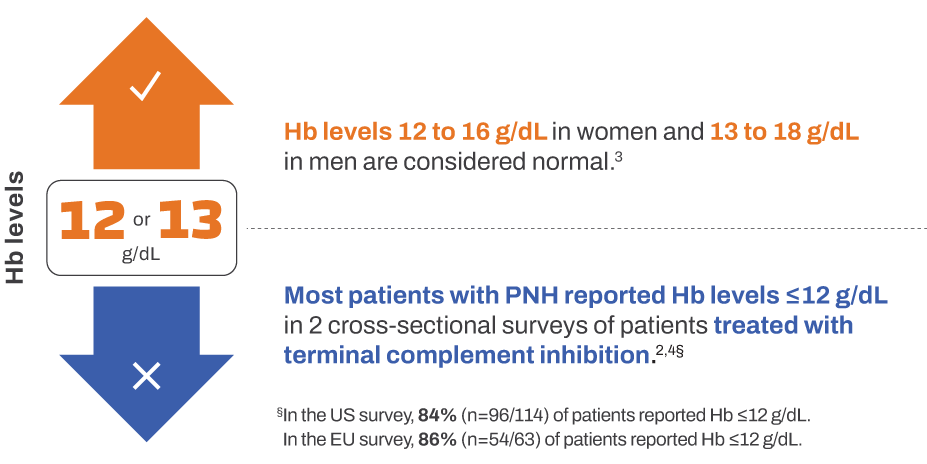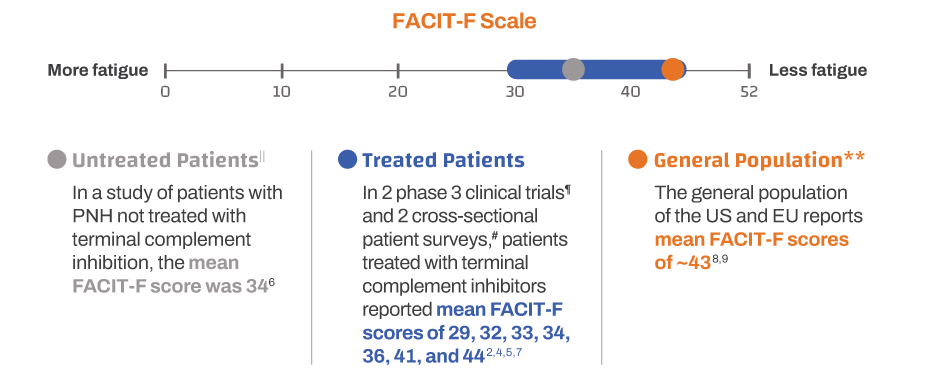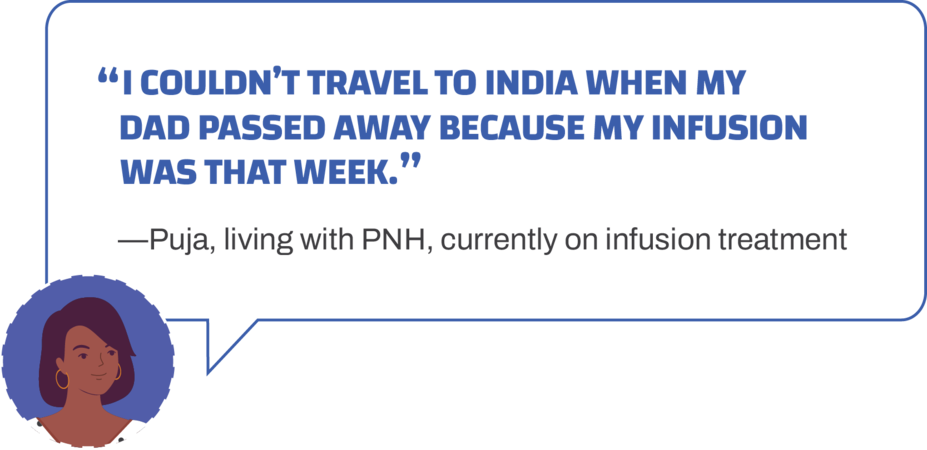Despite terminal complement inhibition, hemolysis can persist
Despite terminal complement inhibition, patients with PNH may remain anemic and fatigued
The Functional Assessment of Chronic Illness Therapy-Fatigue (FACIT-F) is a 13-item questionnaire that collects information about the intensity of fatigue and how it impacts daily life. It is a patient-reported measure often used in clinical trials. Scores on the FACIT-F scale range from 0 to 52, with lower scores indicating more severe fatigue.2,5
Larger increases in Hb correlate with greater improvements in fatigue10
||FACIT-F score was reported by 1894 untreated adult patients with PNH as of July 2017.6
¶One phase 3, open-label, controlled trial from 2021 assessed the efficacy and safety of 2 complement inhibitors (N=80). The second study was a 2-year follow-up from 2022 of 2 phase 3 studies comparing the efficacy and safety of 2 complement inhibitors (N=441).5,7
#The US survey (N=122) and EU survey (N=71) evaluated the relationship between exposure to terminal complement inhibitors and clinical parameters, PNH symptoms, quality-of-life outcomes, and FACIT-F scores in patients with self-reported diagnoses of PNH.2,4
**FACIT-F scores for general population was determined through assessment of 1010 adults in 2002 and 2426 adults in Germany in 2018.8,9
¶One phase 3, open-label, controlled trial from 2021 assessed the efficacy and safety of 2 complement inhibitors (N=80). The second study was a 2-year follow-up from 2022 of 2 phase 3 studies comparing the efficacy and safety of 2 complement inhibitors (N=441).5,7
#The US survey (N=122) and EU survey (N=71) evaluated the relationship between exposure to terminal complement inhibitors and clinical parameters, PNH symptoms, quality-of-life outcomes, and FACIT-F scores in patients with self-reported diagnoses of PNH.2,4
**FACIT-F scores for general population was determined through assessment of 1010 adults in 2002 and 2426 adults in Germany in 2018.8,9
Complement inhibitors given by infusion require patients to adapt their lives around scheduling infusion treatment
Ask your patients if they struggle with persistent symptoms and current treatment strategies
Explore the role of proximal complement inhibition in PNH
Hb, hemoglobin; LDH, lactate dehydrogenase; MOD, mechanism of disease; PNH, paroxysmal nocturnal hemoglobinuria; RBC, red blood cell.
References: 1. Risitano AM et al. Blood. 2009;113(17):4094-4100. 2. Dingli D et al. Ann Hematol. 2022;101(2):251-263. 3. Cappellini MD et al. Semin Hematol. 2015;52(4):261-269. doi.10.1053/j.seminhematol. 2015.07.006 4. Panse J et al. Eur J Haematol. 2022;109(4):351-363. doi.10.1111/ejh.13816 5. Hillmen P et al. N Engl J Med. 2021;384(11):1028-1037. doi:10.1056/NEJMoa2029073 6. Schrezenmeier H et al. Ann Hematol. 2020;99(7):1505-1514. 7. Kulasekararaj AG et al. Eur J Haematol. 2022;109(3): 205-214. doi:10.1111/ejh.13783 8. Montan I et al. Value Health. 2018;21(11):1313-1321. doi.10.1016/j.jval2018.03.013 9. Cella D et al. Cancer. 2002;94(2):528-538.doi.10.1002/cncr.10245 10. Cella D et al. Ann Hematol. 2022;101(9):1905-1914. doi.10.1007/s00277-022-04887-8 11. Brodsky RA. Blood. 2014;124(18):2804-2811. doi:10.1182/blood-2014-02-522128 12. Hill A et al. Haematologica. 2010;95(4):567-573. 13. Hillmen P et al. Br J Haematol. 2013;162(1):62-73. 14. Mastellos DC et al. Expert Rev Hematol. 2014;7(5):583-598. 15. Roth A et al. Blood. 2020;135(12):912-920. 16. Notaro R, Luzzatto L. N Engl J Med. 2022;387(2):160-166. doi:10.1056/NEJMra2201664
References: 1. Risitano AM et al. Blood. 2009;113(17):4094-4100. 2. Dingli D et al. Ann Hematol. 2022;101(2):251-263. 3. Cappellini MD et al. Semin Hematol. 2015;52(4):261-269. doi.10.1053/j.seminhematol. 2015.07.006 4. Panse J et al. Eur J Haematol. 2022;109(4):351-363. doi.10.1111/ejh.13816 5. Hillmen P et al. N Engl J Med. 2021;384(11):1028-1037. doi:10.1056/NEJMoa2029073 6. Schrezenmeier H et al. Ann Hematol. 2020;99(7):1505-1514. 7. Kulasekararaj AG et al. Eur J Haematol. 2022;109(3): 205-214. doi:10.1111/ejh.13783 8. Montan I et al. Value Health. 2018;21(11):1313-1321. doi.10.1016/j.jval2018.03.013 9. Cella D et al. Cancer. 2002;94(2):528-538.doi.10.1002/cncr.10245 10. Cella D et al. Ann Hematol. 2022;101(9):1905-1914. doi.10.1007/s00277-022-04887-8 11. Brodsky RA. Blood. 2014;124(18):2804-2811. doi:10.1182/blood-2014-02-522128 12. Hill A et al. Haematologica. 2010;95(4):567-573. 13. Hillmen P et al. Br J Haematol. 2013;162(1):62-73. 14. Mastellos DC et al. Expert Rev Hematol. 2014;7(5):583-598. 15. Roth A et al. Blood. 2020;135(12):912-920. 16. Notaro R, Luzzatto L. N Engl J Med. 2022;387(2):160-166. doi:10.1056/NEJMra2201664

